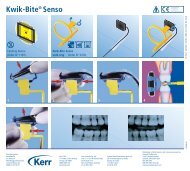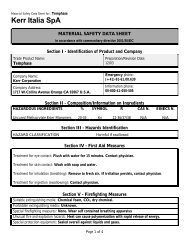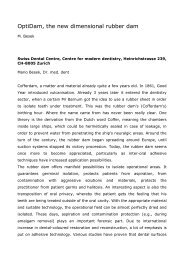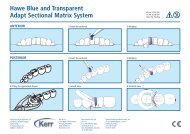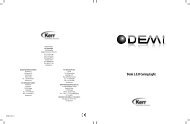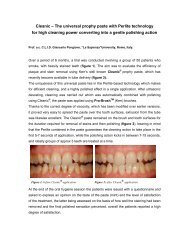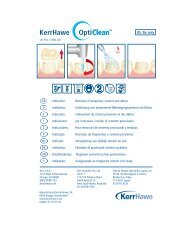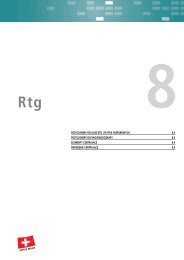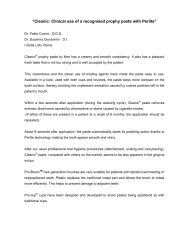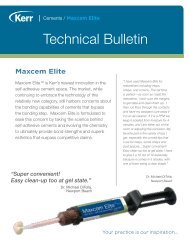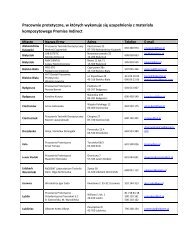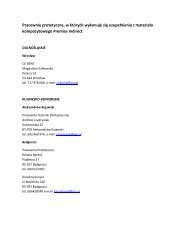Restorative Procedure - Kerr Hawe
Restorative Procedure - Kerr Hawe
Restorative Procedure - Kerr Hawe
You also want an ePaper? Increase the reach of your titles
YUMPU automatically turns print PDFs into web optimized ePapers that Google loves.
When two monomers combine the molecular<br />
structure is shortened, and it can be concluded<br />
that the greater degree of conversion will increase<br />
the percentage of contraction, because the overall<br />
length of a polymer is less than that of the individual<br />
monomers. In fact, the monomers combine with<br />
covalent bonds, assuming a distance between one<br />
another that is three times lower than that of the<br />
Van der Waals bonds that exist between one<br />
monomer and another. For this reason, a composite<br />
will contract more when used in a single mass than<br />
with minimal successive increments.<br />
The direction of contraction depends on the shape<br />
of the cavity and the strength of adhesion. In fact,<br />
adhesive placed on the walls of the cavity opposes<br />
the contraction of the composite, so that the<br />
surface of the material that contracts in contact<br />
with a wall of the cavity cannot contract because<br />
of the prevailing effect of the adhesive. Therefore,<br />
if the composite is in contact with one wall only,<br />
the contraction takes place towards it and involves<br />
all the other free surfaces. If there are two walls,<br />
the remaining unsupported surface will be left free<br />
to contract; if all the walls of a cavity are present,<br />
the composite adheres to them and the only wall<br />
free to contract is the occlusal one. Therefore, the<br />
greater the number of walls to which the composite<br />
adheres, the greater is the C-factor, that is, the<br />
relationship between the adhesive surface and<br />
the free surface and thus the greater is the stress<br />
to which the material will be subjected when<br />
contracting, as Feilzer stated in 1987. The stress<br />
within the tooth-composite interface has been<br />
measured at about 4 MPa for each surface.<br />
During polymerisation, there are two phases, one<br />
called the pre-gel phase in which contraction of<br />
the composite is compensated by the intrinsic<br />
flowing of the material, so as to diminish the<br />
contraction and reduce stress; the second is called<br />
the post-gel phase, separated from the former by a<br />
gel point, in which the material is no longer able to<br />
run to compensate the contraction so that stress<br />
is produced. A rigid composite will have a higher<br />
modulus of elasticity or Young’s modulus, and<br />
will develop more stress during polymerisation,<br />
having a shorter pre-gel phase; conversely, a<br />
fluid composite will have a lower modulus of<br />
elasticity with a longer pre-gel phase.<br />
Although the composites are regarded as optimal<br />
materials, they certainly have certain limits that<br />
may potentially frustrate the aims of a restoration.<br />
The main deficiency, and this applies for all classes<br />
of composite including the hybrids, is contraction<br />
on polymerisation, that is, the reduction in volume<br />
that the resin undergoes during the polyaddition<br />
phase, once the reaction has begun. It can be<br />
concluded that at the end of the restoration a<br />
marginal fissure will form between the tooth and<br />
obturation caused by the contraction; on the other<br />
hand, absence of the formation of a fissure introduces<br />
tensile forces into the reconstituted element<br />
that will be discharge either on the residual tooth<br />
walls, with the risk of fracturing them, or on the<br />
body of the obturation; the result will be the same<br />
for the three analysed outcomes that should be<br />
considered, however unlikely they may be: failure<br />
of the restoration. To avoid this, cases that may<br />
undergo direct restorative treatment with composite<br />
resins should be assessed carefully, following the<br />
instructions for use and observing the limitations<br />
that are still present, albeit reduced, especially in<br />
the case of the hybrids.<br />
Even if the evolution of the composites has probably<br />
approached its technological limit, there is certainly<br />
scope for improvement and it is permissible to<br />
expect that in the near future there will yet be a<br />
composite resin, even self-adhesive, that will be<br />
the material of choice in aesthetic reconstructions.<br />
It may also be considered that the hybrids come<br />
closest to the ideal material from the aesthetic<br />
aspect, although, like all composites, they are<br />
affected by technical problems that have not yet<br />
been fully resolved.<br />
References<br />
1. Ceruti A, Mangani F, Putignano A. Odontoiatria estetica adesiva – Didattica<br />
Multimediale. Ed. Quintessence. 2008 Cap.1; p:18-20.<br />
2. Christensen GJ. Longevity versus Esthetics. The Great <strong>Restorative</strong> Debate.<br />
JADA 2007, 138, 1013-1015.<br />
3. Raj V, Macedo GV, Ritter AV. Longevity of Posterior Composite Restorations.<br />
Journal Compilation 2007, 19(1), 3-5.<br />
4. Abe Y, Lambrechts P, Inoue S, et al. Dynamic elastic modulus of “packable”<br />
composites. Dent Mater 2001;17:520-5.<br />
5. Burgess JO, Walker R, Davidson JM. Posterior resin-based composite:<br />
review of the literature. Pediatr Dent 2002;24:465-79. Review.<br />
6. Dino R, Cerutti A, Mangani F, Putignano A. Restauri estetico-adesivi indiretti<br />
parziali nei settori posteriori. Ed.U.T.E.T. 2007 Cap. 2; p: 18-22.<br />
7. Christensen GJ. Preventing postoperative tooth sensitivity in class I, II and<br />
V restorations. J Am Dent Assoc 2002;133:229-31.<br />
8. Fabianelli A, Goracci C, Ferrari M. Sealing ability of packable resin<br />
composites in class II restorations. J Adhes Dent 2003 Fall; 5:217-23<br />
9. Lee IB, Son HH, Um CM. Rheologic properties of flowable, conventional<br />
hybrid, and condensable composite resins. Dent Mater 2003;19:298-307.<br />
20<br />
Your practice is our inspiration.



